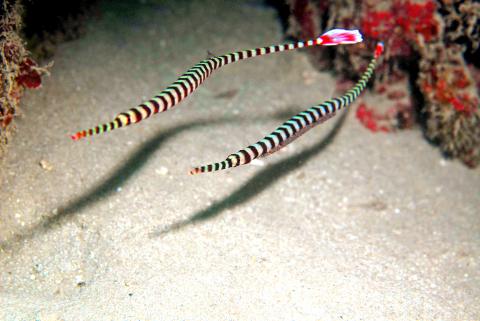The National Museum of Marine Biology and Aquarium in Pingtung County has established a new record by breeding the ringed pipefish (Dunckerocampus dactyliophorus), becoming the first institution in the world to do so.
The museum said that the achievement serves as an important reference for future egg-hatching and fish-fry cultivation projects and helps to ease the strain caused by commercial fishing, allowing local fishermen more time to prepare for the imminent challenge of the depleting amount of economic fish faced by fishing communities throughout the world.
By simulating the fish’s living environment with underwater caves and fissured corals, the museum was able to provide an environment where the fish could hatch their eggs, the museum said.

Photo: Copy by Tsai Tsung-hsien, Taipei Times
The average survival rate of the fish stood at about 37 percent on the 100th day after hatching, it said, adding that the first batch of offspring began mating in the 11th month post-hatching.
According to the museum, although pipefish are not an endangered species, more than 30 million are caught and sold each year because Asian consumers view them as a precious material for traditional Chinese medicine and it is highly sought after by aquariums around the world. These twin demands have led to its population diminishing over time.
The museum said that by conducting artificial breeding projects, marine biologists are able to improve their understanding of different species’ needs for survival and aid the preservation of rare and endangered species.
Ringed pipefish generally inhabit the Indian and Pacific oceans. Adults have a dark yellow body ringed with crimson or dark brown stripes from their mouths to their tails. The fish’s tail — red with white banding and a white dot in its center — makes them instantly identifiable.
The museum said that wild ringed pipefish are only interested in live food; if they cannot adapt to their food in captivity, they can become underweight or die.
There is very limited literature on ringed pipefish laying eggs or on breeding fry in captivity, it said, adding that the successful breeding provides valuable input for future artificial breeding projects.

US climber Alex Honnold is to attempt to scale Taipei 101 without a rope and harness in a live Netflix special on Jan. 24, the streaming platform announced on Wednesday. Accounting for the time difference, the two-hour broadcast of Honnold’s climb, called Skyscraper Live, is to air on Jan. 23 in the US, Netflix said in a statement. Honnold, 40, was the first person ever to free solo climb the 900m El Capitan rock formation in Yosemite National Park — a feat that was recorded and later made into the 2018 documentary film Free Solo. Netflix previewed Skyscraper Live in October, after videos

NUMBERS IMBALANCE: More than 4 million Taiwanese have visited China this year, while only about half a million Chinese have visited here Beijing has yet to respond to Taiwan’s requests for negotiation over matters related to the recovery of cross-strait tourism, the Tourism Administration said yesterday. Taiwan’s tourism authority issued the statement after Chinese-language daily the China Times reported yesterday that the government’s policy of banning group tours to China does not stop Taiwanese from visiting the country. As of October, more than 4.2 million had traveled to China this year, exceeding last year. Beijing estimated the number of Taiwanese tourists in China could reach 4.5 million this year. By contrast, only 500,000 Chinese tourists are expected in Taiwan, the report said. The report

Temperatures are forecast to drop steadily as a continental cold air mass moves across Taiwan, with some areas also likely to see heavy rainfall, the Central Weather Administration (CWA) said. From today through early tomorrow, a cold air mass would keep temperatures low across central and northern Taiwan, and the eastern half of Taiwan proper, with isolated brief showers forecast along Keelung’s north coast, Taipei and New Taipei City’s mountainous areas and eastern Taiwan, it said. Lows of 11°C to 15°C are forecast in central and northern Taiwan, Yilan County, and the outlying Kinmen and Lienchiang (Matsu) counties, and 14°C to 17°C

STEERING FAILURE: The first boat of its class is experiencing teething issues as it readies for acceptance by the navy, according to a recent story about rudder failure The Hai Kun (海鯤), the nation’s first locally built submarine, allegedly suffered a total failure of stern hydraulic systems during the second round of sea acceptance trials on June 26, and sailors were forced to manually operate the X-rudder to turn the submarine and return to port, news Web site Mirror Daily reported yesterday. The report said that tugboats following the Hai Kun assisted the submarine in avoiding collisions with other ships due to the X-rudder malfunctioning. At the time of the report, the submarine had completed its trials and was scheduled to begin diving and surfacing tests in shallow areas. The X-rudder,